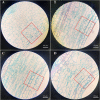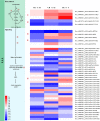Strigolactones modulate stem length and diameter of cherry rootstocks through interaction with other hormone signaling pathways
- PMID: 36844087
- PMCID: PMC9948674
- DOI: 10.3389/fpls.2023.1092654
Strigolactones modulate stem length and diameter of cherry rootstocks through interaction with other hormone signaling pathways
Abstract
Stem growth and development has considerable effects on plant architecture and yield performance. Strigolactones (SLs) modulate shoot branching and root architecture in plants. However, the molecular mechanisms underlying SLs regulate cherry rootstocks stem growth and development remain unclear. Our studies showed that the synthetic SL analog rac-GR24 and the biosynthetic inhibitor TIS108 affected stem length and diameter, aboveground weight, and chlorophyll content. The stem length of cherry rootstocks following TIS108 treatment reached a maximum value of 6.97 cm, which was much higher than that following rac-GR24 treatments at 30 days after treatment. Stem paraffin section showed that SLs affected cell size. A total of 1936, 743, and 1656 differentially expressed genes (DEGs) were observed in stems treated with 10 μM rac-GR24, 0.1 μM rac-GR24, and 10 μM TIS108, respectively. RNA-seq results highlighted several DEGs, including CKX, LOG, YUCCA, AUX, and EXP, which play vital roles in stem growth and development. UPLC-3Q-MS analysis revealed that SL analogs and inhibitors affected the levels of several hormones in the stems. The endogenous GA3 content of stems increased significantly with 0.1 μM rac-GR24 or 10 μM TIS108 treatment, which is consistent with changes in the stem length following the same treatments. This study demonstrated that SLs affected stem growth of cherry rootstocks by changing other endogenous hormone levels. These results provide a solid theoretical basis for using SLs to modulate plant height and achieve sweet cherry dwarfing and high-density cultivation.
Keywords: cherry rootstocks; differentially expressed genes; stem growth and development; strigolactones; transcriptomics.
Copyright © 2023 Liu, Xu, Sun, Wang, Gao, Wang, Xu, Wang, Jiu and Zhang.
Conflict of interest statement
The authors declare that the research was conducted in the absence of any commercial or financial relationships that could be construed as a potential conflict of interest.
Figures











Similar articles
-
Strigolactones affect the yield of Tartary buckwheat by regulating endogenous hormone levels.BMC Plant Biol. 2024 Apr 24;24(1):320. doi: 10.1186/s12870-024-05029-0. BMC Plant Biol. 2024. PMID: 38654155 Free PMC article.
-
The Role of Strigolactones in the Regulation of Root System Architecture in Grapevine (Vitis vinifera L.) in Response to Root-Restriction Cultivation.Int J Mol Sci. 2021 Aug 16;22(16):8799. doi: 10.3390/ijms22168799. Int J Mol Sci. 2021. PMID: 34445508 Free PMC article.
-
Identification and expression of strigolactone biosynthesis and signaling genes and the in vitro effects of strigolactones in olive (Olea europaea L.).Plant Direct. 2024 Feb 25;8(2):e568. doi: 10.1002/pld3.568. eCollection 2024 Feb. Plant Direct. 2024. PMID: 38405354 Free PMC article.
-
Contribution of strigolactone in plant physiology, hormonal interaction and abiotic stresses.Planta. 2021 Jul 9;254(2):28. doi: 10.1007/s00425-021-03678-1. Planta. 2021. PMID: 34241703 Review.
-
Perception and Signaling of Strigolactones.Front Plant Sci. 2016 Aug 23;7:1260. doi: 10.3389/fpls.2016.01260. eCollection 2016. Front Plant Sci. 2016. PMID: 27602041 Free PMC article. Review.
Cited by
-
Metabolomic and transcriptomic basis of photoperiodic response regulation in broomcorn millet (Panicum miliaceum L.).Sci Rep. 2024 Sep 17;14(1):21720. doi: 10.1038/s41598-024-72568-9. Sci Rep. 2024. PMID: 39289492 Free PMC article.
References
LinkOut - more resources
Full Text Sources
Miscellaneous

